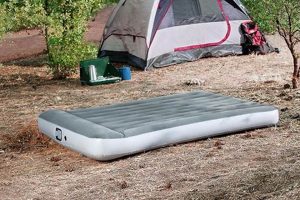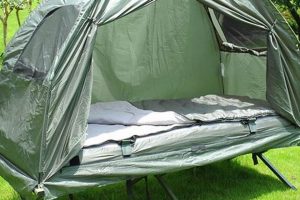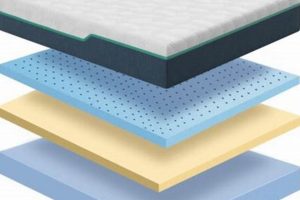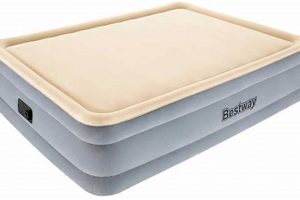Pinpointing the source of air leakage in an inflatable sleeping surface is essential for maintaining its functionality. Locating the precise point of escape allows for effective repair, extending the lifespan of the product and ensuring continued usability. This process generally involves a systematic examination of the mattress surface to identify areas where air is escaping.
Successfully identifying and repairing damage to such items prevents the need for replacement, offering both economic and environmental benefits. Repairing extends the item’s usability, reducing waste and minimizing the financial burden associated with purchasing new equipment. The ability to locate and mend such issues contributes to resource conservation and promotes sustainable practices.
The following sections will detail practical methods for detecting leak sources, including auditory, tactile, and visual inspection techniques, along with soap and water solutions. Each method provides a distinct approach to pinpointing the precise location needing attention for effective repair.
Effective Leak Detection Strategies
Locating the precise source of air escape is paramount for effective air mattress repair. The following tips outline systematic approaches to achieve this objective.
Tip 1: Auditory Examination: Initiate the process by inflating the mattress fully in a quiet environment. Carefully listen for hissing or whistling sounds, particularly around seams, valves, and corners. These auditory cues can indicate a concentrated area of air leakage.
Tip 2: Tactile Investigation: Systematically run a hand slowly over the entire surface of the inflated mattress. Subtle air currents emanating from a puncture may be detectable on the skin, providing a physical indication of the leak location.
Tip 3: Visual Inspection Under Illumination: Conduct a thorough visual examination under bright light, paying close attention to areas prone to stress or wear. Look for subtle distortions, surface irregularities, or small openings that may indicate a breach in the material.
Tip 4: Soap and Water Solution Application: Mix a small amount of mild soap with water. Apply the solution with a sponge or spray bottle to small sections of the inflated mattress. The formation of bubbles indicates the presence of escaping air and pinpoints the leak’s location.
Tip 5: Submersion Technique (for Smaller Mattresses): For smaller air mattresses, submerge the inflated mattress section by section in a tub of water. Observe the water surface for rising bubbles, which will reveal the location of air escaping from the puncture.
Tip 6: Valve Assessment: Examine the inflation valve for proper closure and seal. Apply the soap and water solution to the valve area to determine if the leak originates from a faulty valve mechanism.
These methods offer a comprehensive strategy for isolating the leak location, facilitating targeted repair and extending the lifespan of the air mattress.
With successful leak identification, the next step involves employing appropriate repair techniques to restore the functionality of the mattress.
1. Inflation Level
The degree of inflation significantly influences the ease with which a puncture can be located in an air mattress. An under-inflated mattress may not exhibit sufficient air pressure to force air out of a small breach, rendering detection difficult. Conversely, an over-inflated mattress can place undue stress on the material, potentially exacerbating existing damage or creating new points of failure, thereby complicating the identification process. Therefore, maintaining optimal inflation is crucial for effective puncture identification. A moderately inflated mattress provides a balance, allowing sufficient air pressure to reveal leaks while minimizing the risk of further damage.
Consider the example of attempting to locate a small pinhole leak. If the mattress is significantly deflated, the air pressure inside may be insufficient to generate a detectable air stream or bubble formation when using leak detection solutions. In contrast, if the mattress is inflated beyond its recommended capacity, the resulting tension can enlarge existing small punctures, making it harder to pinpoint the original source of the leak from the now larger compromised area. The ideal inflation level ensures that the escaping air is concentrated enough to be identified using auditory, tactile, or visual methods without altering the original characteristics of the puncture.
In summary, the appropriate degree of inflation is a prerequisite for effectively locating punctures in air mattresses. Too little inflation impedes air escape, while excessive inflation can distort the leakage pattern. Therefore, adhering to the manufacturer’s recommended inflation guidelines is paramount for accurate leak detection and subsequent repair. This understanding is vital for extending the lifespan of air mattresses and minimizing the need for replacement.
2. Auditory Clues
Auditory cues represent a primary, non-invasive method for identifying leaks in air mattresses. The sound of escaping air, often characterized as a hiss or whistle, provides an immediate indication of a potential breach and guides the search area.
- Proximity and Sound Intensity
The loudness of the escaping air is directly related to the size of the puncture and the internal pressure of the mattress. A louder, more distinct hissing sound generally suggests a larger opening or a location closer to the listener. This allows for a coarse localization of the leak’s origin. For example, a faint whisper-like sound might indicate a pinhole, while a pronounced hissing noise suggests a more significant tear. The sound’s intensity aids in prioritizing areas for closer inspection.
- Sound Characteristics and Material Interaction
The specific tonal qualities of the sound can be influenced by the material surrounding the puncture. Air escaping through a clean, smooth opening will produce a different sound than air forced through a rough or constricted tear. Listening for variations in pitch or timbre can provide subtle clues about the nature of the damage. The sound might be muffled if the puncture is partially obstructed by fabric or bedding, indicating the need to clear the surrounding area for a more precise assessment.
- Ambient Noise Interference
The effectiveness of auditory leak detection is significantly affected by ambient noise levels. A quiet environment is essential for accurate identification of subtle air leaks. Extraneous sounds, such as traffic, conversations, or machinery, can mask the hissing sound of escaping air. Reducing or eliminating background noise is a prerequisite for relying on auditory cues. In noisy environments, alternative detectio
n methods, such as soapy water solutions, may prove more effective. - Valve Leakage Differentiation
It is crucial to differentiate between air escaping from a puncture in the mattress material and leakage originating from a faulty valve. Valve leaks often produce a consistent, rhythmic hissing sound, emanating directly from the valve mechanism. Applying pressure to the valve or manipulating its position may alter the sound, confirming its origin. Mistaking valve leakage for a puncture elsewhere on the mattress can lead to wasted time and effort in an incorrect search area. Isolating the valve as a potential source is a necessary step in the auditory leak detection process.
Auditory clues serve as an initial, rapid assessment tool in the process of locating leaks. While not always sufficient as a standalone method, carefully listening for the sound of escaping air provides valuable information for narrowing the search and directing subsequent investigation using other detection techniques. This information can be pivotal in understanding how to find puncture in air mattress.
3. Visual Scrutiny
Visual scrutiny represents a critical stage in identifying the source of air leakage within an inflatable mattress. The connection lies in the potential for direct observation of damage. Many punctures or tears, particularly those of substantial size, manifest as visually discernible anomalies on the mattress surface. A thorough visual inspection, therefore, can often provide the most immediate and definitive confirmation of a leak’s location.
The importance of visual inspection stems from its capacity to detect not only obvious punctures but also subtle indicators of structural weakness or impending failure. For instance, a small pinhole may not be readily apparent, but a surrounding area of discoloration or stretching might betray its presence. Similarly, a seam separation, even if initially minute, can be identified through careful observation of the seam’s integrity and alignment. Consider the scenario of a mattress used frequently outdoors; visual examination might reveal small cuts from sharp objects or abrasion damage from rough surfaces, directly indicating potential leak points. In another instance, noticing a small raised area or blister-like formation could point to a weakening in the material’s integrity, a precursor to a rupture. Visual scrutiny also involves examining valve areas for cracks or deformities, which compromise the airtight seal. Success relies on both the availability of adequate lighting and systematic approach.
In summary, visual scrutiny forms an indispensable component in the process of determining the source of air loss from inflatable sleeping surfaces. Its effectiveness hinges on careful observation and a methodical approach, enabling the identification of both overt damage and subtle signs of potential leaks. The insights gained from visual inspection inform subsequent, more targeted leak detection methods, such as the application of soapy water, contributing to an efficient and effective repair process.
4. Tactile Sensation
Tactile sensation, the ability to perceive air movement or surface variations through touch, serves as a valuable tool in identifying breaches. A direct correlation exists between the presence of an air leak and the subtle sensation of air escaping from the compromised area. This method relies on the user’s sensitivity to air currents and surface textures to pinpoint areas requiring further investigation.
The significance of tactile sensation stems from its capacity to detect minute air leaks that might evade both auditory and visual detection. For example, a pinhole puncture, too small to produce an audible hiss or a readily visible distortion, can often be located by feeling the slight air current emanating from the opening. The hand, serving as a sensitive instrument, can detect the cool sensation created by the escaping air. Similarly, tactile inspection can reveal subtle surface irregularities, such as raised areas or rough patches, which may indicate a compromised section of material. Consider a scenario where a mattress has been patched previously; the edges of the patch might not be perfectly smooth, creating a subtle textural difference that can be detected through touch, potentially signaling a new or recurring leak in that area. The effectiveness of tactile sensation is contingent on a slow, deliberate approach, allowing sufficient time for the user to perceive subtle variations in air movement or surface texture.
In summary, tactile sensation constitutes an integral component of leak detection procedures. Its capacity to reveal subtle air currents and surface anomalies complements other detection methods, increasing the likelihood of successfully identifying the location. While potentially subjective, the sensitivity can be refined.Tactile identification of damage, and the resulting need for mattress repair is a key step in extending the lifespan and usefulness of the item. Mastering the method requires practice and patience, but the rewards are realized through more effective and complete puncture identification.
5. Soapy Solution
The application of a soapy solution represents a widely employed and highly effective technique in pinpointing the origin of air leakage from inflatable mattresses. The method leverages the properties of soap to create visible indicators of escaping air, transforming otherwise imperceptible leaks into readily identifiable points of interest.
- Bubble Formation as a Visual Indicator
The primary function of the soapy solution is to generate bubbles at the point of air escape. The surfactant properties of soap reduce the surface tension of water, allowing it to stretch and form a film when exposed to a stream of air. This film manifests as a visible bubble, directly marking the location. The rate of bubble formation corresponds to the severity of the leak; larger leaks produce rapidly expanding bubbles, while smaller leaks result in slower, more gradual bubble formation. For example, a small pinhole leak may generate a slow, steady stream of small bubbles, whereas a larger tear will produce rapidly expanding, larger bubbles.
- Solution Consistency and Application Techniques
The effectiveness of the soapy solution depends on its consistency and application. A solution that is too concentrated may leave a soapy residue that obscures the surface, while a solution that is too diluted may not produce sufficient bubbles. A balanced solution, typically a mixture of mild dish soap and water, is ideal. The solution can be applied using a sponge, spray bottle, or brush. The application should be systematic, covering small sections of the mattress at a time to ensure thorough coverage. For example, when dealing with a large mattress, working in grid-like sections ensures that no area is missed.
- Environmental Factors and Solution Performance
Environmental conditions can influence the performance of the soapy solution. Wind can disrupt bubble formation, making it difficult to pinpoint the leak. Direct sunlight can cause the solution to dry quickly, reducing its effectiveness. Optimal conditions involve a ca
lm, shaded environment. Temperature also plays a role; extremely cold temperatures can cause the solution to freeze, while very high temperatures can accelerate evaporation. Maintaining a moderate temperature range improves solution performance. For example, avoid applying the solution outdoors on a windy, sunny day. - Post-Application Cleaning and Material Compatibility
Following leak detection, it is crucial to thoroughly clean the mattress surface to remove any remaining soapy solution. Failure to do so can leave a sticky residue that attracts dirt and can potentially degrade the mattress material over time. The type of cleaning method should be compatible with the mattress material; a damp cloth is generally sufficient for most surfaces. Harsh chemicals or abrasive cleaners should be avoided, as they can damage the material. For example, after locating the leak, wipe the area clean with a damp cloth and allow it to air dry completely before patching.
These facets collectively illustrate how a soapy solution serves as an indispensable method for identifying punctures. The combination of bubble formation, proper application techniques, consideration of environmental factors, and appropriate post-application cleaning ensures an accurate and effective leak detection process.
Frequently Asked Questions
The following addresses commonly encountered inquiries pertaining to the location of perforations in inflatable sleeping surfaces.
Question 1: Why is finding the exact location of a puncture important?
Precise puncture localization is crucial for effective repair. Pinpointing the damage allows for targeted patching, preventing further air loss and prolonging the lifespan of the mattress. General or imprecise repair attempts may fail to adequately seal the leak, resulting in continued deflation.
Question 2: What is the most effective method for locating small punctures?
The soapy water solution method is generally considered the most reliable for identifying small punctures. The formation of bubbles at the leak point provides a clear visual indication, even for minute perforations that might otherwise go unnoticed.
Question 3: Can punctures occur in areas other than the main sleeping surface?
Yes, punctures can occur in various locations, including seams, valves, and the underside of the mattress. Each area requires careful inspection. Seams are vulnerable due to stress, valves can develop leaks due to wear, and the underside is susceptible to damage from contact with the ground.
Question 4: Is it possible to identify multiple punctures simultaneously?
Identifying multiple punctures simultaneously can be challenging, especially if the leaks are close together. A systematic approach, applying leak detection methods sequentially to small sections of the mattress, increases the likelihood of identifying all sources of air loss.
Question 5: How does humidity affect the accuracy of leak detection methods?
High humidity levels can potentially interfere with certain leak detection methods. Excess moisture on the mattress surface can mimic the appearance of bubbles, leading to false positives. Ensuring a dry surface before applying leak detection solutions enhances accuracy.
Question 6: Can previous repairs compromise the accuracy of future leak detection?
Yes, previous repairs can potentially obscure or complicate future leak detection. Adhesives or patching materials may alter the surface characteristics, making it difficult to identify new punctures in the vicinity of the repair. Thorough cleaning and visual inspection are crucial in these situations.
Accurate and efficient identification is paramount for maintaining the usability. Understanding the strengths and limitations of each technique maximizes the chances of success.
The next section will explore appropriate repair techniques and materials to ensure a long-lasting solution for identified damage.
Conclusion
The process of effectively locating the source of air leakage in an inflatable sleeping surface relies upon a systematic approach, integrating multiple detection methodologies. Auditory examination, tactile investigation, visual scrutiny, and the judicious application of soapy solutions collectively contribute to a comprehensive strategy. Understanding the nuances of each method, alongside the potential for environmental interference, is crucial for accurate puncture identification.
Mastery of these techniques ensures prolonged usability, minimizing the need for replacements and supporting sustainable consumption practices. Diligence in identifying and addressing even minor perforations safeguards the integrity of the mattress and ensures its continued performance. Further research and development into more sensitive and reliable leak detection technologies represent a potential avenue for enhancing user experience and extending product lifespan.







